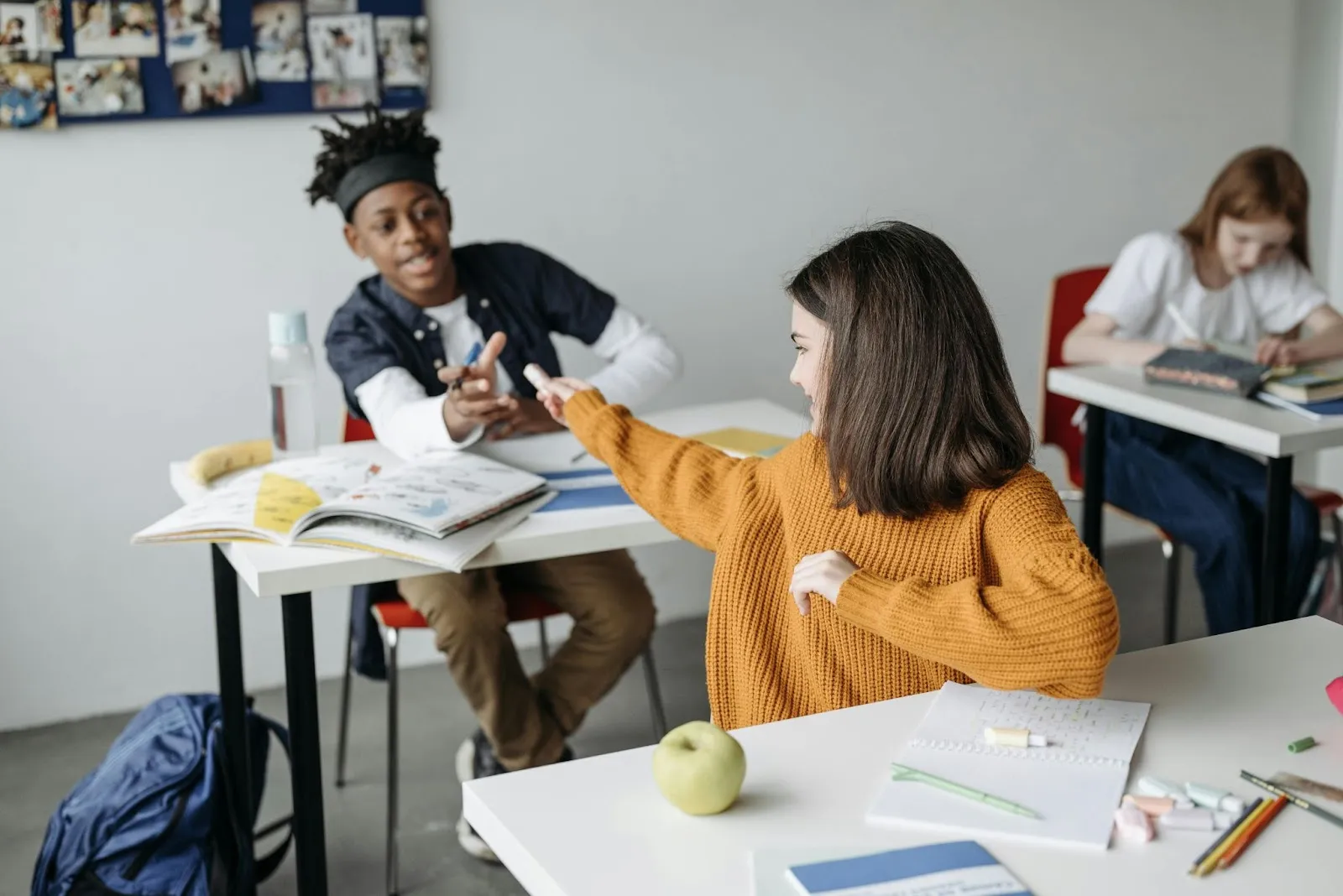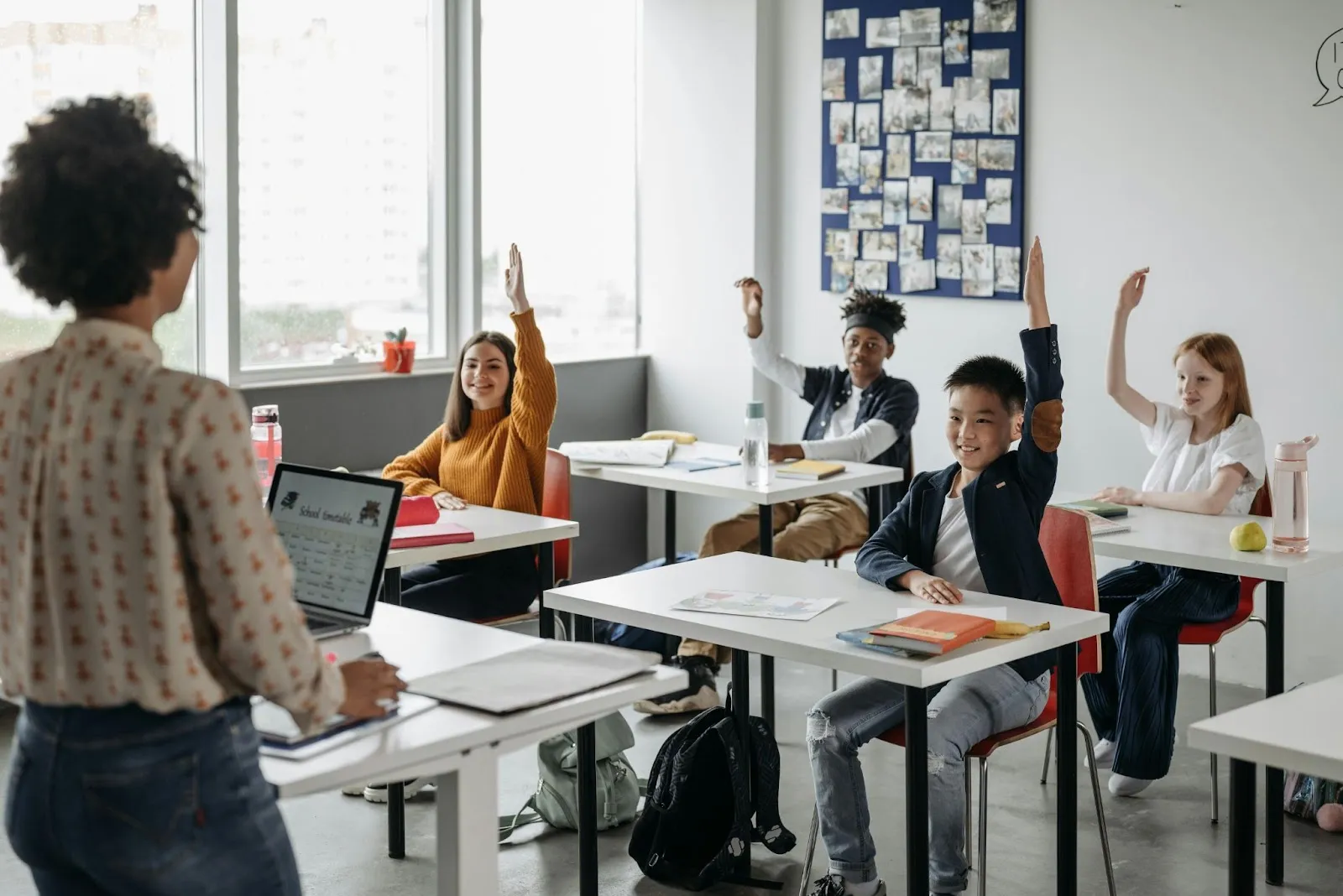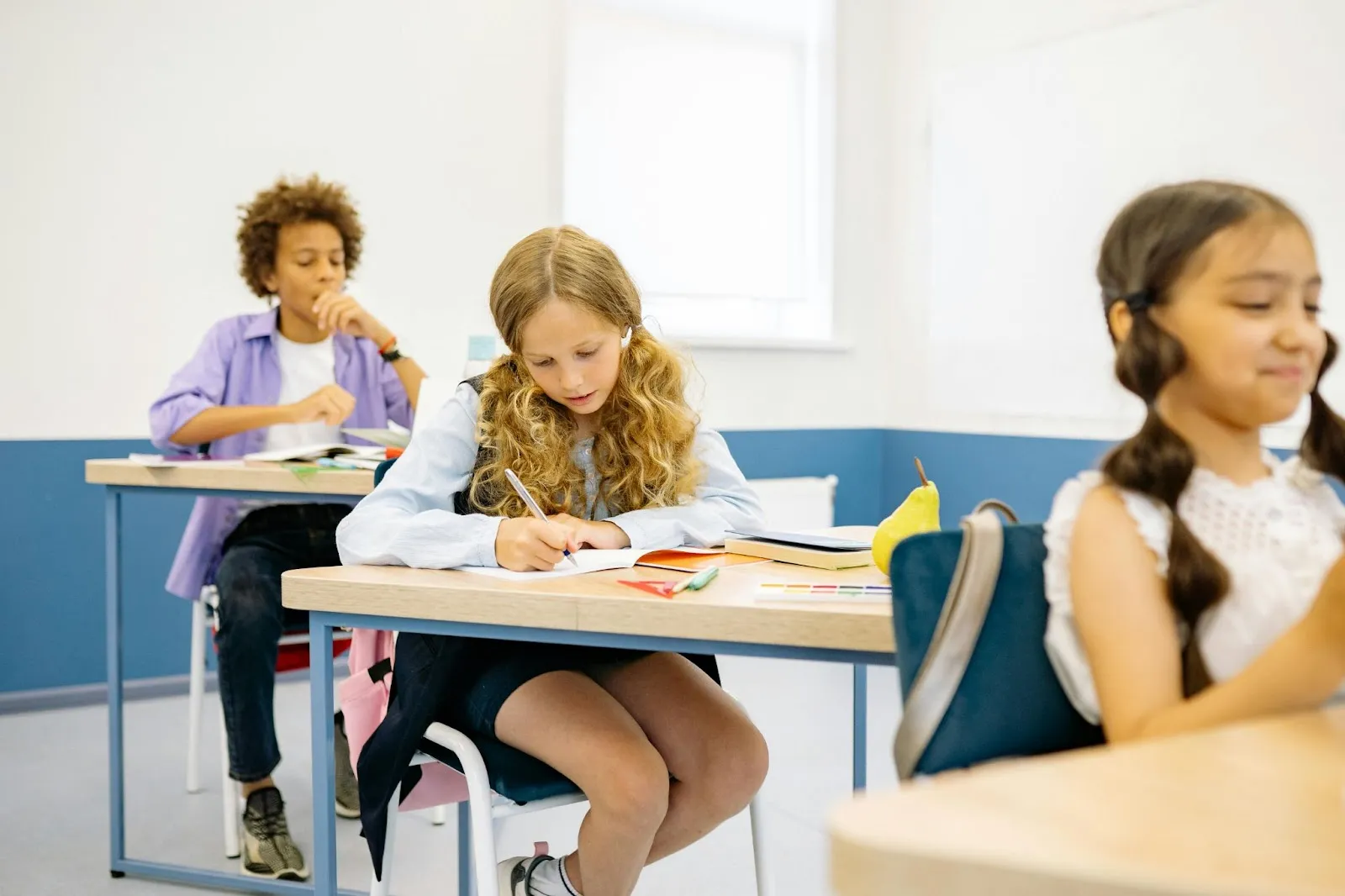Have you ever walked into an unfamiliar environment only to feel that instant cold sweat of anxiety as you realize you have no idea what to do or where to go? For some, this place is the airport. For others, it’s the DMV. However, it’s not uncommon for unclear procedures to cause disruptions in stores, restaurants, gas stations, or residential buildings. Whatever the environment, procedures help a person clarify their goal, their objectives, and their needs, ultimately reducing the likelihood of confusion, anxiety, or even injury.
Procedures are prescriptive. They tell people what to do.
And knowing what to do is a very emotionally and physically safe space to be.
School buildings and individual classrooms are unique and diverse new environments for students. Walking into this new environment is sure to cause some uncertainty and fear. As a teacher, you don’t want to cause your students distress, and you certainly don’t want to create more work for yourself by establishing weak or unintuitive procedures.
In this blog, we will discuss what experts say about establishing and maintaining classroom procedures. We’ll provide comprehensive tips and examples of effective classroom procedures so you can identify needs in your classroom. You’ll even hear from an expert at Eduphoria who knows a thing or two about classroom management.
Jump ahead
Why are classroom procedures important?
Research shows that classrooms without procedures aren't safe learning environments
An example classroom procedure
How to adjust existing procedures
An example classroom procedure
Students sometimes need extrinsic motivation
Always be the best model of your own procedures
Be accommodating to students with unique needs
Accommodating for each student extends to the lessons you prepare
Connect with Eduphoria for more trustworthy tips and information

We know that procedures work, but why do they work? What happens if you start class tomorrow and let students guess your intentions for them rather than directly teaching them?
While some classrooms would be blessed to miss full on anarchy, many teachers would struggle to maintain control of a classroom that hadn’t been grounded with procedures. Research says that there’s a reason students need the structure and safety of procedures. And it’s not because they like causing trouble.
Ambiguity (such as a lack of clear expectations in a certain setting) causes anxiety, and anxiety leads to frustration, anger, and fear. In one study from the National Institute of Health (NIH), adolescents with Anxiety Disorders felt threatened and employed avoidant strategies (which may look like work refusal, isolation, or procrastination) when faced with ambiguity. It’s upsetting to imagine that students who are deeply affected by anxiety may feel fear in a classroom without clear guidelines and expectations. However, it’s not just students with Anxiety Disorders who are affected.
Another study describes the negative effects of uncertainty and ambiguity on the general population:
Uncertainty diminishes how efficiently and effectively we can prepare for the future, and thus contributes to anxiety.
We all experience anxiety because of uncertainty. We feel fear because we can not effectively plan, prepare, and mitigate possible negative consequences. While some people experience this on a clinical level, humans, in general, experience this because of our instinct to avoid harm.
It makes sense that students will experience anxiety in the face of uncertain or ambiguous expectations. Education experts agree that structure and clarity can help students feel safe and make smart decisions.
The Educational Resources Information Center (ERIC) published an article about classroom management that cites a study of a single disorganized classroom. The study attributed 80 percent of disruptive behavior in this classroom to poor organization, planning, and teaching.
In the words of the author, “Behavior problems in a classroom increase the stress levels for both the teacher and pupils, disrupt the flow of lessons and conflict with both learning objectives and the processes of learning.”
Another resource from the NIH states that “successful classroom instruction is contingent upon effective classroom management to maintain appropriate student behavior, engagement, and subsequently, academic achievement.” This resource links to several studies showing a direct relationship between classroom management and student disruption. Some research even shows that strong classroom management has a positive effect on student achievement.
According to this research, it’s important to have a well-organized, structured classroom. Not just for your stress. Not just for your student’s stress. But for their confidence and ability to succeed.
If you’ve gotten to this point, and you’re thinking, “Well, it’s easier said than done,” we couldn’t agree more. For the rest of this article, we’ll include tips, strategies, and instructions on how you can create an organized classroom that is held together by iron-clad procedures.

If you have at least a year of teaching under your belt, then you can skip ahead to the next section. You’ll use needs identified from your previous year(s) to improve your process.
New teachers, it can be hard to imagine what your classroom will be like if you’ve never been in charge of one. For one thing, your students will change and present new challenges from year to year. For another, you can’t always predict the areas in which your students will need explicit teaching. What seems like common sense to you may not be common sense to them.
So, here’s where to start:
- Get with your mentor or PLC team. They can tell you what each day will generally look like. Structured classrooms with similar lesson formats from day to day are much easier to plan for. (For example, if each day starts with a bellringer and ends with a discussion.) If their lesson plans aren’t as structured and predictable as you’d like, ask for input on how you can create that structure.
- Visualize your students’ journey from the moment they enter your classroom. How are they going to enter? Where are they coming from? What will be expected of them before they sit, while they’re sitting, and once they need to get up? What needs will they have while they’re present? How will they exit? What will they do once they’re at home to prepare for the next day?
- Write procedural outlines using the student’s journey. Answer the questions above! What should the student do? What is your part in these procedures, and how should the student account for outliers? For example, if something doesn’t fit into the rules you prescribe, how (and who) can they ask for clarification?
- Decide how you’re going to teach and reinforce these procedures. It doesn’t matter the age. Students need signage. They need reminders. They need positive reinforcement. So, how will you teach these things and, more importantly, how will you keep the procedures as part of your daily routine?
Once you talk with your PLC team, you may start to identify some needs. Let’s say your mentor tells you that each class period in your department starts with five minutes of quiet work time followed by a discussion about the prompt on the board. This is something that needs a procedure. Here’s how one might tackle that:
What is the need? Students need to come into the classroom quiet and prepared to engage. They should have supplies ready, should interact with the prompt, and then be prepared to share their responses.
What procedure will I establish? Students will sit and get out their bellringer notebook to work quietly until the alarm goes off. I will share my own response to the bellringer before asking volunteers to share.
How will I teach this procedure? I will have a schedule on the board outlining my expectations for that class period and a pointer showing which activity we’re currently working on. For the first week or so, I will direct them to complete this portion of the class step-by-step.
How can I reinforce this procedure? I will tell the students what to expect, reinforcing habits for the first several weeks as necessary. For example, I may verbally remind students to check the bellringer, get supplies out, or work quietly. I will verbally recognize students who follow this procedure and reward them with a sticker. I will remind students who are struggling with verbal cues and visual reminders. For easy reference, I will provide class schedules to paste inside their bellringer notebook.
Are there any outliers? It’s likely that students may come without their bellringer notebook or supplies. If they come without their supplies, I will have paper and pencils at the front of the room for them to grab when they come in. I will verbally explain to them that these supplies are there to use at any time (supported by signage), and I would prefer that they grab what they need when they enter instead of in the middle of class time.
You’re not the all-seeing eye. You can’t anticipate how certain things will go over until you teach them. Sometimes the procedure is good but the teaching process could have been better. Sometimes, the procedure won’t work for the group of students you’ve got that year.
The way to prepare students for changes in procedure is to establish a precedent for new rules and procedures throughout the year so new procedures don’t seem like a desperate plea for control. Here are some tips to help that go over better:
- For the first week or three, try teaching your class a new procedure or rule every day (or, for a younger group, every other day). Procedures may stick better this way than if they were all taught in one day.
- Continue adding new procedures as necessary, perhaps every month or every six weeks. It would be even better if there was a dedicated day for this. You’ve got a new unit coming up with new expectations about labs, after-school projects, or essays–use the first day of the new six weeks to teach that procedure.
- When you need to modify an existing procedure, it may help improve student buy-in when you ask them for their feedback. What are they noticing about the procedure that’s not working? What would they suggest to fix it? Would they like to create the signs that you will use around the classroom to remind them of the procedure?
- Use their creativity and expertise to modify your existing procedure, then teach, reinforce, and practice that procedure as you have been for the rest of the school year.
Whatever happens, be kind to yourself. Teaching is more than just sharing subject matter expertise; it takes years to become a process expert. Teach students to roll with the punches, and it’ll give you more room to do the same.

Whether you’ve got a year of teaching under your belt, or you’re counting your years of experience in groups of five, it’s always helpful to look back on your previous year of teaching to modify classroom procedures.
You probably already have a list of things you wish had gone better. Now’s the time to get that list out, or get started on it. If you need some help generating ideas for areas of improvement, start with a list of things that caused you stress on a daily basis. What aspects of your schedule and procedures seemed unclear to students or weren’t as effective as you’d hoped?
Think about:
- How students entered and exited the classroom
- How students handled food, drinks, and gum
- How students asked for help or clarification
- How students transitioned between activities
- How students stopped and listened to directions
- How students used and put away their cell phones
- How students responded to missed deadlines or late work policies
If you feel a certain kind of way about how any of these things went, then it’s probably time to adapt your existing procedure.
What is the need? Students coming in from lunch bring their drinks and leftovers into the classroom. They eat at their desks and then leave their trash for me to pick up.
What procedure will I establish? I’m already standing at the door to greet them when they come in, and I have a trash can ready to receive their leftovers.
How will I teach this procedure? If students bring food into the room on the first day, we will have a group-wide discussion about expectations for the future. They will then have the opportunity to dispose of their trash. Regardless, on the first day, I will outline what it will look like for them as I wait for them at the door tomorrow. I will post a sign at the door that no food or drinks are allowed past that point, and I will include written documentation in the syllabus. If they come in late with food, then I will verbally direct them to throw it away.
How can I reinforce this procedure? I will thank and congratulate students for disposing of their trash without comment, showing me that they’re prepared and ready for the lesson. I will issue verbal reminders as necessary and may point to the signage for students who are hesitant to follow the procedure.
What about the outliers? Let’s say a student didn’t have time to eat their lunch and came with a full bag of food. This isn’t a common occurrence. Perhaps for this classroom, you allow that student ten minutes to eat and then dispose of their trash with the caveat that any further occurrences will result in tardy passes.

Students don’t stop wanting stickers. Age is not a factor in whether a person wants free things. Everyone wants free things.
This resource from the IRIS Center has a great chart on when to award certain kinds of positive reinforcement. While some rewards can be given daily, such as stickers for students who follow morning procedures, some rewards can be given rarely or intermittently (for long-term, consistent positive behavior).
This IRIS Center resource also includes information about administering negative consequences. The consequences that you establish and reinforce are their own kind of procedure that you must administer with consistency and compassion for that student. Some teachers even have a consequence system that dictates consequences consistently and fairly for every infraction. That way, students know the consequences, no matter the behavior.
For example, students should never be shamed or embarrassed for inappropriate behavior. Every negative consequence should be given with neutrality, never manipulating that student’s emotions for the sake of compliance. Consequences should never be specific for that student, using their fears, likes, and dislikes for the sake of punishment.
One aspect of consistent punishment is that punishments shouldn’t be administered on a whim. The student needs to see and feel the escalation, so they know a consequence is merited. One way to be consistent is to issue corrections that slow that inclination towards a consequence and give the student a second chance to change their behavior.
Here are some examples of positive, neutral corrections that can be used to slow that path towards punishment and defuse a situation:
“Remember that we have a full five minutes of quiet time before you can talk with your neighbors. I will let you know when that time is up.”
“I noticed that you’re having a hard time being quiet and respectful when I’m teaching today. Could we reset and try again?”
“It looks like you’re getting a little bit worked up and upset about this. Do you need to go take a break and grab a drink of water before you come back and tell me what’s going on?”
When behaviors persist after correction, then it’s time to follow your procedures and your system for fair and neutral consequences.
Make sure the consequence is proportional to the behavior.
Consequences shouldn’t feel to the student like the end of the world. They should feel like they can come back the next day (or even the next ten minutes) and be better. Things like automatic zeroes or permanent reseating can make the student feel like there’s no coming back from that level of punishment. At that point, why try? If there’s no way of earning back a reward or classroom comfort, then the student may give up entirely.
Not only is it better for student buy-in to slow the walk toward more intense punishment, but it will help you maintain that trust and control. If the first or second infraction results in an office referral, the students may feel like they can’t trust you to evaluate the situation fairly. That loss of trust and relationship will only cause further disciplinary issues.

If you’ve ever taught high school, you know how brutally honest and observant the students are. If they catch you breaking your own rule or going soft on a procedure, they’ll straight up ask you: “Why are you eating in here when we can’t?” or “I thought we couldn’t text during class.”
You may correct one student’s behavior and ignore another’s, and they notice. They may feel like you’re picking on them unfairly or another student is getting preferential treatment.
It’s human nature to be upset when things are unfair, especially if it looks (from their perspective) like you can do what you want because you’re an adult and they are not. Or that you can decide not to participate in a procedure but they can not.
Modeling the behaviors you want to see isn’t just a measure of fairness that helps students identify with and invest in the well-being of the group. It’s an extremely effective teaching tool that helps students to see and emulate positive behaviors.
Take every opportunity to model the behaviors you want to see, including by self-correcting and apologizing when you make a mistake.
You are as accountable for the balance of behavior in the classroom as the students. Teachers who agree to hold themselves to the same standards that they hold their students will have an easier time correcting behaviors and connecting with those students.

Classroom procedures that don’t work for one student will not work for the classroom as a whole.
We are not saying that some students should have unique procedures or consequences. It’s not a good idea to single out a specific student who gets more or less leeway than others.
One student may actually get more leeway, according to their behavior plans. They may get more patience or even have specific action plans for poor behavior, but it’s not the business of the other students to know or see that. They will either identify the difference in treatment as unfair or preferential, which is not good for your trust with the students.
The basic rule, procedure, and consequence system should be the same across the board, and if it doesn’t work for one student, it needs to be reworked to include all students.
Here are some examples of ways you can accommodate students by modifying a procedure for every student:
- One student tends to shut down and refuse work when called out in front of others. Rather than modifying the procedure for this student by not calling them out verbally, adapt the procedure so that call-outs are relatively silent for every student. Try tapping on desks, pointing to signage, or indicating which warning they’re on before elevating to verbal cues.
- One student struggles to hear and acknowledge instructions when there’s background classroom noise. Make it a procedure to silence the entire room with hand signals or music before giving out instructions. This will benefit the entire classroom, not just that one student.
- One student needs a lot of information and guidance before they’re comfortable continuing on to the assignment or activity. Rather than planning to spend more time with that student to repeat instructions and miss opportunities to connect with others, make it a procedure to include several levels of support and explanation (such as teacher-led instructions, group-led re-teaching, and self-led exploration), so each student (even the one who won’t vocalize their confusion) is ready to proceed.
A classroom that is accommodating for one is accommodating for all. After all, only some students with unique needs will have those needs documented on their student forms or IEPs. Classrooms that are accommodating are non-judgmental, inclusive, and well-controlled.
Organized and well-controlled classrooms are more than just the systems in which they exist. Teachers should make connections to each of their students, not just for their comfort and well-being, but for their personal and academic success.
A resource on classroom management from Edweek says “The foundation to all effective student management is knowing who [your students] are (not who they should be, who they ought to be, or even who the system says they are), and purposefully building a rapport and trust with them.”
Our Eduphoria expert couldn’t agree more. Marie Hayes is one of our Coaching and Curriculum Management Experts. After two decades in education as a teacher, instructional coach, and curriculum coordinator, she decided to lend her expertise to Eduphoria as an account manager. Here’s what she has to say about building relationships in the classroom:
Students are much more than their test scores. Take some time to find out what makes them tick. What are their interests, connections, strengths, challenges or struggles? Once you have this inside scoop, build engagement by keeping the focus on how your students learn best. Incorporate those details that they shared with you to help make connections to them and their real world. Let’s move away from being knowledge providers and teach them instead how to internalize the information to connect it to something relevant to them. When the knowledge becomes something that feels real through these connections, this will then naturally partner with higher achievement and scores.
Teaching to the individual interests of your students is a classroom management strategy that will double as an engagement kickstarter and relationship builder. Engagement is often directly related to achievement (Social Behavior and Personality).
So, while you present your students with lessons that cater to their interests, learning needs, and individual differences, they will naturally come to trust you, engage with your curriculum, and excel in the classroom.
At Eduphoria, we rely on our experience as educators and our connections with schools to create trustworthy, relevant content for teachers. You don’t have all the time in the world to find answers to your questions, so we aim to create complete, reliable resources that help you improve your practice and reduce your stress.
For updates on all of our publications, follow us on socials. We’d love to connect with you and continue to offer high-quality, teacher-approved content throughout the school year.


.webp)


.png)
.webp)